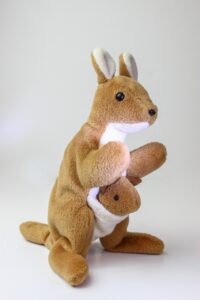Beanie Babies. Those cute little beanbags were insanely popular in the late 90s and early 00s – they led to human stampedes in Hallmark Stores, for goodness’s sake! Twenty plus years on, the market for them is…considerably less competitive. Today, we’re going to have a look at why that is.
Scarcity Relative To Demand
Let’s look to another hot collectible of the 1990s first: comic books. New titles, new issue #1s, and new characters were filling a demand created by millions of speculators looking for the next Action Comics #1. Into that flooded market came X-Files #1, released by Topps Comics in late 1994. It was a “special numbered edition”, with each copy in the first print run numbered out of the 120,000 total. In an era where Youngblood #1 sold 2.5 million copies and X-Men #1 8.1 million copies, that was a modest printing for a comic based on a popular TV series.

Pouch The Kangaroo, a Beanie Baby introduced in 1997 and retired in 1999.
Today, selling out that run would land it comfortably in the Top 50 best selling comics of the year. The early 90s new comic market was a bubble, and it burst dramatically before the decade was out. Topps Comics itself was out of business by the end of 1998. X-Files #1, once something of a limited edition, is now common fodder for bargain back issues bins.
The same factors apply with Beanie Babies. They were a fad, a hot new craze that quickly drew an audience of millions. But eventually, that audience lost interest. The bubble grew until it popped, and folks who had bought Beanie Babies as a collectible investment were left holding the bag.
Artificial Scarcity Increases Demand
The Beanie Baby craze represents a masterstroke of marketing and market manipulation. At every stage, the supply of Beanie Babies was deliberately limited to stoke demand. First, they were originally only sold at small toy and gift stores. Second, each design was only produced in a limited quantity. Third, each store was limited in the quantity of any given design it could receive – including major retailers once they got in on the action. And finally, Beanie Baby designs would frequently be “retired” to make way for new ones. The fact that Ty Inc. kept these limits in place even as their product exploded in popularity helped Beanie Babies achieve and hold onto an image as a top shelf collectible. Consequently, their secondary market value grew exponentially.
But it was a bubble! And Ty knew it. All the measures that kept Beanie Babies rare relative to demand also prevented the company from over-investing. In fact, a requirement that retailers carry their other lines was built into their Beanie Baby sales agreements. This left Ty products on shelves even after Beanie Baby sales started to scale back dramatically. It’s probably why they’re still around today, long after most folks stopped thinking about their signature product.
Beanie Babies Aren’t Particularly Valuable
Back to the Past gets calls about Beanie Baby collections practically every day. And most of those collections include the “rare” Princess bear made to memorialize Diana, Princess of Wales in 1997. In their day, Princess bears were indeed hard to find. Now they’re not, no matter what unrealistic listing you see on eBay. See, Ty deliberately kept product runs smaller than demand back in the day. They estimated the demand for the Princess bear, and then made far less than that. That made competition to get one fierce and the secondary market booming. But there simply aren’t millions of people who want a Princess bear anymore.
That doesn’t mean that all Beanie Babies are entirely worthless, but they certainly aren’t the payday most folks are expecting. Licensed specimens, like their small Godzilla line, hold some value to this day. That’s why it is a good idea to let expert eyes, like those of Back to the Past, evaluate your collection…particularly if there’s more to it than just Beanie Babies. If you’ve got a comment or question, feel free to sound off below or hit us up on social media @b2pCollect.
But if you’ve got the iconic red bull or purple platypus? Your best bet is using them to make a kid in your life happy. Feel free to share that wisdom with everyone you know!









How do I sell an antique player piano that works? 70+ music rolls plus bench. It’s a Noble built in the early 1920s.
You’d need a dealer that specializes in large antiques and/or antique instruments. One starting point might be find a piano store in your area that handles used items.